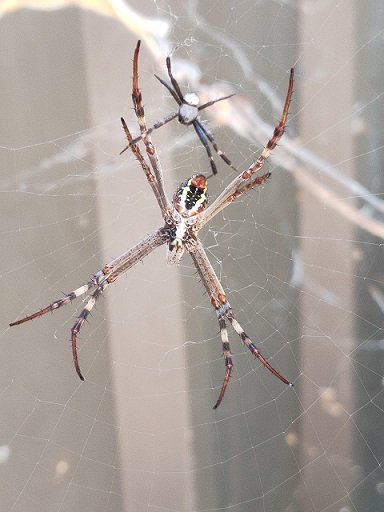If you’ve ever sprayed insecticide on a spider, you might have witnessed it simply shrugging it off and continuing its merry way. Household pesticides commonly contain pyrethroids, compounds that disrupt nerve cells in animals. So why do they work on insects but not on spiders? We look at how spiders could have evolved to resist insecticides because of their venom.
Insecticides don’t work on some spiders because their venom mimics the effects of the active chemicals. They would have evolved venom resistance against cannibalism—which is common in spiders—thereby protecting them from insecticides that work similarly.
How Household Insecticides Work
Insect-Killing Pyrethroids
If you look at the ingredients list of your household insecticides, there’s a good chance that you’ll see at least one of the following chemical compounds:
- Allethrin
- Bifenthrin
- Cyfluthrin
- Cypermethrin
- Flumethrin
- Imiprothrin
- Or another name ending with -thrin
These belong to the class of molecules called pyrethroids, which are excitotoxins. They get their name from being similar in chemical structure to pyrethrins—naturally occurring insecticides in chrysanthemum flowers.

As excitotoxins, pyrethroids overexcite the nerves in animals with a nervous system, effectively causing all their muscles to contract permanently. In insecticides, this paralyzes the insect until it eventually dies.
Sodium and Potassium Ions in Nerve Cells
In humans, we control the muscles in our body by triggering nerves. In invertebrates (like insects and spiders), this is no different. Our nerve cells act as a bridge between the brain and muscles, using electric pulses as messengers.
Nerve cells contain a high potassium ion concentration, while the fluid surrounding them has a high sodium ion concentration. Potassium and sodium ions enter and exit the cell through unique channel proteins, which are usually closed.
When the brain triggers nerve cells, the sodium channel opens, causing sodium on the outside to flood into the cell. When enough sodium has entered, the nerve will fire an electric pulse that activates the muscle.
After firing this pulse, the cell will close these sodium channels and open the potassium channels, allowing potassium to flow out of the cell.
Now the nerve cell contains more sodium than potassium ions. It uses pump proteins to push sodium out and bring potassium back into the cell, reestablishing the original high potassium/low sodium concentration.
During this recharge period, the nerve cannot fire more pulses, allowing the muscle to rest.
Pyrethroids Keep Nerves Firing in Insects
Pyrethroids work by forcing the sodium channels open, causing the nerve cell to fire. Because the sodium channels cannot close, the nerve cell cannot enter the recharge period. Hence, it fires impulses to the muscles non-stop, causing paralysis and death.
Pyrethroids are 2250 times more toxic to insects than mammals due to their smaller body size and lower temperature (pyrethroids are more toxic at lower temperatures).
Furthermore, our skin protects us from absorbing the chemical from the air, while our liver contains CYP450 enzymes that break down toxic compounds.
This means the concentration of pyrethroids in household and commercial insecticides is so low that it is unlikely to cause any harm to humans.
What the Fish!
Hold your seahorses, however. Even though pyrethroids are designed to work against insects, they are highly toxic to aquatic creatures, especially fish.
Fish don’t have the correct CYP450 enzymes to break down pyrethroids, which accumulate in their gills and, combined with lower temperatures underwater, cause them to experience severe toxic effects.
Cats are also susceptible to pyrethroid poisoning, as they don’t metabolize the chemicals as effectively as dogs, birds and humans.
But this doesn’t explain why spiders—having all the disadvantages of insects and without the advantages of mammals—can resist pyrethroid insecticides so well. What do they have going for them?
Pyrethroid Resistance in Spiders
Evidence for Insecticide Resistance
Few studies test the effectiveness of insecticides for spiders; they don’t generally fall under the category of pests. Though most spiders are venomous, they tend to be rather shy toward humans. Insecticide research mainly focuses on their effectiveness against insects like roaches and mosquitos.
A 2005 study tested the pyrethroid cyfluthrin against hobo spiders and black widows, spraying it on their webs, in their enclosure, or directly onto them. The black widow spiders were susceptible to cyfluthrin at household pesticide levels, dying within one day of exposure regardless of application type.
Hobo spiders had better resistance to cyfluthrin, surviving for several days even when the insecticide was sprayed directly. Interestingly, female hobo spiders had a higher level of resistance than males. Hobo spider females are slightly larger than males, which is common in spiders due to sexual dimorphism.
Comparing Spider Venom with Pyrethroids
Almost all spiders are venomous, using toxins to subdue insects—their prey—before sucking out their insides. Some bio-pesticides are actually made with spider venom! Let’s compare the similarities between these and pyrethroids.
Black widows produce venom that creates calcium channels in nerve cells, causing calcium ions to flow into the cell. This releases neurotransmitters like dopamine in massive amounts, triggering a cascade of pain and loss of muscle control.
The mechanism of black widow venom differs from how pyrethroids work, activating sodium channels. What about jumping spiders (the largest family of spiders) and funnel-web spiders (considered the deadliest)?

A 2018 study showed that jumping spiders and funnel-web spiders produce venom that works in the same way as pyrethroids, opening the sodium channels in their nerve cells to cause muscle contraction, paralyzing their prey.
So far, we know that spiders are not so different from insects. Theoretically, pyrethroids in insecticides would be just as effective in killing them. While this is the case for certain species of spiders, spiders that produce venom affecting sodium and potassium channels (like pyrethroids) could be resistant.
Protecting Against Your Own Kind
Why would spiders need resistance against their own venom, you might ask? Spiders are cannibalistic, which means they eat others of the same species. The most common form of spider cannibalism is during mating, where the female will try to kill and eat the male spider after copulation.
Male Saint Andrew’s Cross spiders (the smaller spider in the image below) often have missing limbs due to attacks by females during mating.

Other forms of cannibalism, like males eating females, are also seen in rare cases where males of the species are bigger than females. In some species, the offspring eat the mother after hatching.
There is also cannibalism between newly hatched siblings and widespread cannibalism when spiders are hungry.
It sure is a wild world out there if you’re a spider. It is definitely an evolutionary advantage to develop resistance to your venom, increasing your chances of survival.
Although there isn’t much research to confirm this theory, cannibalism has driven other animals to develop protection against others of the same species.
Komodo Dragons and Venom Resistance
Komodo dragons, like spiders, are cannibalistic, especially toward their young. Adults are also highly aggressive, competing for territory, food and mates.
Their saliva contains a cocktail of venomous proteins, including an anticoagulant toxin that prevents blood clots from forming over wounds, causing their bite victims to bleed profusely.
However, Komodos have evolved to produce coagulation proteins in their blood. These help to counteract the effects of the anticoagulant venom if they are bitten by another Komodo, increasing their chances of survival.
The Best Way to Get Rid of Spiders?
Although spiders are venomous, they tend to be wary of humans, preferring to run instead of attacking us. Furthermore, spider bites are rarely fatal. The funnel-web spider, considered to have the most lethal venom, hasn’t killed a human since 1980.
Though they may look scary, spiders help us trap and kill common household pests like flies and cockroaches. If we want to get rid of spiders around the house, our best bet would be to use sticky traps rather than insecticides—especially those that contain pyrethroids.
About the Author

Sean is a consultant for clients in the pharmaceutical industry and is an associate lecturer at La Trobe University, where unfortunate undergrads are subject to his ramblings on chemistry and pharmacology.



